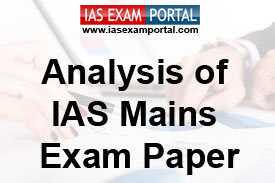(HOT) UPSC Current Affairs 2025 PDF
NEW! The Gist (NOV-2025) | E-BOOKS
Analysis of IAS Mains 2015: General Studies Question Paper - II

Analysis of IAS Mains 2015: General Studies Question Paper - II
Each question carries 12.5 Marks (12.5×20 = 250 Marks)
GS Paper-2 deals with Polity & Governance, Social Justice & Welfare and International-Relations (IR)+
| GS Mains Paper-2 | 2015 |
| Evolution of Constitution | 37.5 |
| Separation of Powers | 12.5 |
| Federal Structure & Local Administration | 25 |
| Constitutional, Regulatory, Statutory and Quasi- Judicial Bodies | 25 |
| Urban and Rural Welfare Schemes | 12.5 |
| Social Sectors & Services | 25 |
| Accountability, E-Governance and Citizen Charter | 25 |
| NGO, SHG, Pressure Groups and Civil Services | 37.5 |
| Foreign Policy of India | 25 |
| Neighbors of India | 25 |

Polity: Evolution of Constitution
- Discuss the possible factors that inhibit India from enacting for its citizens a uniform civil code as provided for in the Directive Principles of State Policy.
- Khap Panchayats have been in the news for functioning as extra-constitutional authorities, often delivering pronouncements amounting to human rights violations. Discuss critically the actions taken by the legislative, executive and the judiciary to set the things right in this regard.
- Does the right to clean environment entail legal regulations on burning crackers during Diwali? Discuss in the light of Article 21 of the Indian Constitution and Judgement(s) of the Apex Court in this regard.
Polity: Separation of Powers
- Resorting to ordinances has always raised concern on violation of the spirit of separation of powers doctrine. While noting the rationales justifying the power to promulgate ordinances, analyze whether the decisions of the Supreme Court on the issue have further facilitated resorting to this power. Should the power to promulgate ordinances be repealed?
Polity: Federal Structure & Local Administration
- The concept of cooperative federalism has been increasingly emphasized in recent years. Highlight the drawbacks in the existing structure and the extent to which cooperative federalism would answer the shortcomings.
- In absence of a well-educated and organized local level government system, `Panchayats’ and ‘Samitis’ have remained mainly political institutions and not effective instruments of governance. Critically discuss.
Polity: Constitutional, Regulatory, Statutory and Quasi- Judicial Bodies
- What are the major changes brought in the Arbitration and Conciliation Act, 1996 through the recent Ordinance promulgated by the President? How far will it improve India’s dispute resolution mechanism? Discuss.
- “For achieving the desired objectives, it is necessary to ensure that the regulatory institutions remain independent and autonomous.” Discuss in the light of the experiences in recent past.
Welfare Schemes : Urban and Rural
- Though there have been several different estimates of poverty in India, all indicate reduction in poverty levels over time. Do you agree? Critically examine with reference to urban and rural poverty indicators.
Welfare: Social Sectors & Services
- The quality of higher education in India requires major improvements to make it internationally competitive. Do you think that the entry of foreign educational institutions would help improve the quality of higher and technical education in the country? Discuss.
- Public health system has limitations in providing universal health coverage. Do you think that the private sector could help in bridging the gap? What other viable alternatives would you suggest?
Governance: Accountability, E-Governance and Citizen Charter
- In the light of the Satyam Scandal (2009), discuss the changes brought in corporate governance to ensure transparency, accountability.
- “If amendment bill to the Whistleblowers Act, 2011 tabled in the Parliament is passed, there may be no one left to protect.” Critically evaluate.
Development : NGO, SHG, Pressure Groups and Civil Services
- Examine critically the recent changes in the rules governing foreign funding of NGOs under the Foreign Contribution (Regulation) Act (FCRA), 1976.
- The Self-Help Group (SHG) Bank Linkage Programme (SBLP), which is India’s own innovation, has proved to be one of the most effective poverty alleviation and women empowerment programmes. Elucidate.
- How can the role of NGOs be strengthened in India for development works relating to protection of the environment? Discuss throwing light on the major constraints.
International Relations : Foreign Policy of India
- Project `Mausam’ is considered a unique foreign policy initiative of the Indian Government to improve relationship with its neighbors. Does the project have a strategic dimension? Discuss.
- Terrorist activities and mutual distrust have clouded India-Pakistan relations. To what extent the use of soft power like sports and cultural exchanges could help generate goodwill between the two countries? Discuss with suitable examples.
International Relations :Neighbors of India
- Increasing interest of India in Africa has its pros and cons. Critically examine.
- Discuss the impediments India is facing in its pursuit of a permanent seat in UN Security Council.

